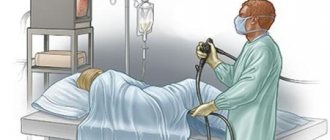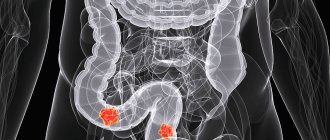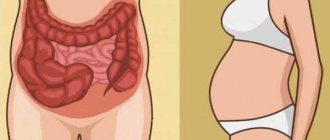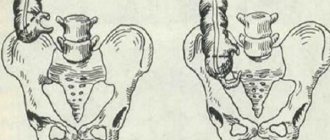Why and which doctor prescribes a colonoscopy?
A colonoscopy procedure is prescribed when it is necessary:
- determination of the condition of the walls of the colon;
- carrying out timely diagnostics;
- prescription of treatment for diseases of this organ.
The study is carried out when the patient complains of problems with the intestines and can be prescribed by several specialists:
- Most often, the doctor who prescribes a colonoscopy is a proctologist. It is he who should be contacted if symptoms indicating intestinal pathologies occur. The doctor, based on the information received from the patient and his own palpation and visual data during examination, makes a decision on prescribing the procedure.
- If a patient consults a physician or gastroenterologist with complaints of a serious intestinal disease, these specialists may prescribe a colonoscopy.
- If there are alarming indicators during a general examination of the patient, the oncologist can also become a doctor who prescribes an examination of the intestines using a colonoscope.
- If the hemoglobin level decreases for no apparent reason, the hematologist may suspect hidden bleeding in the intestines and recommend a procedure.
What does a colonoscopy show?
During a colonoscopy procedure, the doctor literally examines the inside of the intestine for various changes. Key points to pay special attention to:
- color and vascular pattern of the mucous membrane;
- the shape of the intestinal bends and their correspondence to the anatomical norm;
- pathological formations - inflammatory foci, polyps, erosions, ulcerations, suppuration, diverticula, cracks;
- the width and degree of patency of intestinal sections, signs of stenosis (narrowing) and adhesions;
- accumulation of mucus and purulent discharge;
- sources and causes of bleeding.
Based on a visual examination, the doctor makes a conclusion about the condition of the intestines. If there are no critical changes, the mucous membrane is smooth, light, with a moderate vascular pattern and glossy sheen, it is considered that there are no pathologies. If any indicator deviates from the norm, the doctor makes a diagnosis corresponding to these changes.
The list of what a colonoscopy can reveal, as well as changes inherent in diseases, is as follows:
- inflamed mucous membrane with areas of dystrophy or atrophy indicate colitis;
- inflamed foci with ulcerations, suppuration and erosions, purulent discharge, bruising indicate nonspecific ulcerative colitis;
- thickened mucous membrane, which doctors describe as “cobblestone pavement”, scars located longitudinally, ulcers and fistulas indicate Crohn’s disease;
- swelling of the mucous membrane, colored purplish-bluish, hemorrhagic foci, abnormal narrowing of the intestine, ulcers indicate ischemic processes in the intestine;
- bleeding of the mucous membrane, its swelling, narrowing of the intestinal lumen may indicate the development of amyloidosis of the large intestine (the final diagnosis is made after examining a biopsy);
- numerous or single protrusions in the intestinal walls, which look like honeycombs, indicate divetriculosis;
- convex yellow plaques on the surface of the intestinal mucosa indicate the development of pseudomembranous colitis;
- neoplasms of various sizes on the colon mucosa can mean both benign (polyposis) and malignant tumor process (cancer).
Unfortunately, colonoscopy does not allow you to accurately determine the nature of some formations at the time of examination. To make a diagnosis, microscopic and histological analysis of neoplasm tissue is required. Confirmation of the presence of oncology is also carried out using an occult blood test, but more often this type of diagnosis is used before a colonoscopy.
Indications for use
For diagnostic purposes, colonoscopy is performed in a number of cases:
- constant discomfort and pain in the abdominal cavity;
- pain in the anal area;
- suspicion of intestinal obstruction;
- pus and mucous discharge from the intestine;
- unstable stool (alternating diarrhea and diarrhea);
- impaired intestinal motility (regular constipation);
- sudden unreasonable weight loss;
- Crohn's disease;
- presence of a predisposition to cancer;
- anemia of unknown etiology;
- elevated temperature;
- nonspecific ulcerative colitis;
- intestinal bleeding;
- tissue sampling for examination when neoplasms of various etiologies are detected;
- traces of blood in the contents of the distal colon;
- unsatisfactory results of intestinal examination by other methods;
- planned gynecological surgery.
The procedure can be prescribed for therapeutic purposes:
- removal of a foreign body;
- electrocoagulation of polyps;
- stopping intestinal bleeding;
- removal of small benign neoplasms;
- restoration of colonic patency.
Sometimes, colonoscopy is prescribed additionally after sigmoidoscopy to clarify the diagnosis. For people over 50 years of age, the procedure is recommended annually for preventive purposes.
The video tells about the colonoscopy procedure, who should undergo it and when. Filmed by the channel “Live Healthy!”
Absolute contraindications
Indications under which colonoscopy should not be performed under any circumstances:
- Acute purulent inflammation in the abdominal cavity (peritonitis). A condition that requires emergency surgery. Delay in conducting the study can cause a sharp deterioration and lead to the death of the patient.
- State of shock, with a sharp drop in blood pressure. Carrying out a complex colonoscopy procedure in this condition is unacceptable.
- Serious heart problems - myocardial infarction, acute ischemic disease. These diseases themselves are a threat to the patient’s life. The risk of serious complications is much higher than the expected benefits of the study.
- Ischemic or ulcerative colitis in a rapid form. Carrying out the procedure in this condition can provoke a violation of the integrity of the intestinal walls.
- Rupture of the intestine, with the release of contents into the abdominal cavity. Urgent surgery is necessary to prevent bleeding. Endoscopic examination is not possible.
- Pregnancy. The procedure is a threat to the life of the fetus.
- Pulmonary and heart failure of the last stage. Serious circulatory disorders in such conditions require the close attention of doctors and do not allow various manipulations with the patient.
Relative restrictions
Conditions in which the procedure may not bring the desired result are relative:
- Internal bleeding. The accumulation of blood in the abdominal cavity and colon will not allow a visual examination.
- Recent abdominal surgery on the peritoneum. When performing a colonoscopy, there is a risk of damaging the healing sutures.
- Diverticulitis. Sometimes, protrusion of the intestine, characteristic of this pathology, makes it difficult for the endoscope to pass through and makes it impossible to collect the necessary information.
- Inguinal or umbilical hernia. In some cases, the painful condition and limited patency for the colonoscope due to prolapse of the intestinal loop do not allow the procedure to be considered advisable.
- An artificial heart valve in a patient. Examination is delayed until antibiotic therapy is completed to rule out the possibility of valve infection.
- Poor preparation. If there is even a small amount of feces in the intestines, endoscopy results may be distorted.
Factors under which the doctor determines the advisability of the procedure:
- anal fissure;
- adhesions;
- increased body temperature;
- dolichosigma.
If the doctor’s explanations about the procedure do not influence the patient’s decision and a categorical refusal follows, a colonoscopy is not performed. In some cases, examination is not recommended during menstruation. A specialist, when assessing the general condition of the patient, may postpone the study, despite the absence of obvious contraindications.
How is colonoscopy performed?
The procedure is carried out in a specially equipped room, often on an outpatient basis. The patient is placed on the couch in a lying position on his left side, with his knees pressed to his stomach.
The anal area is treated with an antiseptic, the initial section of the probe is treated with lubricant for better passage, and the device is carefully slowly moved deep into the intestine.
At that time:
When passing the final parts of the rectal area, the patient may feel distension and pressure; when moving the probe along the bend of the colon, moderate pain may occur.
Unpleasant sensations such as bloating or spastic pain can occur when filling the intestines with air in order to straighten the mucous folds.
Children, weakened patients, people with a low pain threshold, impressionable and emotional people, and people with a history of adhesive disease are recommended to carry out the procedure under anesthesia. The duration of the examination is from 10 to 25 minutes.
Colonoscopy requires special preparation from the patient. The quality of the research depends on the responsibility of the person and the degree of preparation.
Preparation includes cleansing the large intestine using special methods:
- The drug "Fortrans".
You need to purchase 4 packages of the drug. Dissolve each packet in a liter of boiled water. The evening before the study, start drinking the resulting solution.
It is recommended to drink 1 liter within 1 hour (a glass every 15 minutes). All 4 liters are drunk within approximately 3-4 hours.
Some patients have difficulty drinking the solution due to its specific taste. It is better to drink Fortrans slowly, in small sips. After drinking the volume, swallow a little diluted lemon juice to reduce nausea and vomiting.
If you can’t manage 4 liters of solution, you can divide its intake: drink 2 liters in the evening, and two early in the morning on an empty stomach, but no later than 4 hours from the scheduled colonoscopy.
Side effects from taking the solution may include increased gas formation, abdominal discomfort, and allergies.
Instead of fortrans:
You can use Prelax in bottles. 400 ml of the drug should be dissolved in 4 liters of boiled water and taken at the same time interval.
Analogue drugs are Lavacol, Forlax, Forteza-Pharm. They are also recommended for preparation. The choice of drug depends on individual tolerance and financial preferences.
- Drink 50 ml of castor oil. After a couple of hours, do two cleansing enemas with a volume of 2-2.5 liters. at intervals of an hour. In the morning before the study, do another cleansing enema until the rinsing water is clean.
This preparation allows you to remove feces and areas of semi-digested foods from the intestinal wall, which can obscure the view with their presence.
In addition to cleansing methods, the patient must adhere to a special diet several days before the procedure.
Typical consequences and complications
Complex endoscopic examination, in some cases, does not pass without consequences, which include:
- bloating due to residual air forced into the intestines;
- pain and spasmodic contractions after removal of growths and tumors;
- headache;
- an unpleasant feeling of discomfort in the epigastrium;
- vomit;
- diarrhea;
- temperature increase;
- painful sensations due to minor damage to the mucous membrane as a result of inaccurate insertion of the endoscope.
In addition, a colonoscopy examination can cause serious complications:
- Violation of the integrity of the intestinal walls (perforation). The contents of the intestine leak into the abdominal cavity and can lead to purulent inflammation. Deterioration of the condition after the examination is a signal for immediate consultation with a doctor.
- The appearance of bleeding. After a therapeutic colonoscopy to remove growths and tumors, the patient may bleed. Children and the elderly are primarily at risk due to thin intestinal walls. Bleeding may begin immediately or 5–7 days after the procedure.
In very rare cases it is possible:
- dysfunction of the respiratory system due to improper anesthesia;
- infection with various diseases (HIV, hepatitis);
- splenic rupture.
To avoid complications during colonoscopy, you must follow your doctor’s instructions and choose a trusted medical facility.
Rules for preparing for the procedure
They are not very complicated, but the effectiveness of the procedure depends on their compliance. In a clogged intestine, the doctor simply cannot see anything, so measures are aimed at cleaning it. You will only have to stick to the special diet for 3 days.
How to properly prepare for a colonoscopy
In addition, two days before the colonoscopy, you need to temporarily stop taking medications containing iron and bismuth. Do not drink activated charcoal or medications that treat arthritis during this period. Medicines that thin the blood (Aspirin, Clexane, etc.) are also prohibited.
It is best to switch exclusively to liquid food on the last day. However, this is at personal discretion.
Nutrition before colonoscopy
From the table you can understand how to effectively create the right menu for these days:
| Recommended Products | Prohibited Products |
| Various fermented milk dishes | Non-heat-treated fruits and vegetables |
| Dishes made from boiled vegetables | Rye flour bread |
| Fully boiled eggs | Canned and pickled preparations, smoked products |
| Vegetable soups with broths | Porridge from pearl barley, wheat, oatmeal |
| Bakery products made from white flour | Legume family crops |
| Low fat meat and fish products | Roasted sunflower seeds, pumpkin seeds; French fries |
| Compotes and fruit drinks, lightly brewed tea | Coffee drinks, milk, chocolate sweets |
| Cheeses, natural butter (cow) | Drinks with added carbon |
| Honey | Salted foods |
| Buckwheat and rice cereals | Alcohol |
The last meal on the day before the colonoscopy is no later than 8 pm. Additionally, you can cleanse with an enema in the evening.
Foods not recommended before colonoscopy
Is it worth having a colonoscopy: arguments for and against
The following arguments may be against having a colonoscopy:
- painful sensations;
- invasive ability;
- possibility of injury;
- dependence on the features of the anatomical structure.
However, with proper preparation and highly professional performance, the procedure is painless and risks are minimized.
The examination allows you to:
- diagnose colon diseases at an early stage;
- visually assess the condition of the mucous membrane and intestinal walls;
- if necessary, carry out therapeutic manipulations.
The study is indispensable in diagnosing colorectal cancer. Possible complications and a number of contraindications are not a reason to refuse colonoscopy, since the expected benefits outweigh the expected risks.











